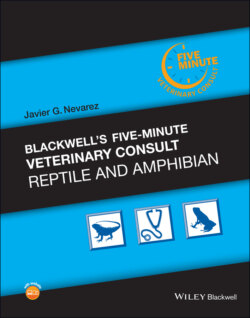Читать книгу Blackwell's Five-Minute Veterinary Consult: Reptile and Amphibian - Javier G. Nevarez - Страница 25
DIGESTIVE SYSTEM
ОглавлениеReptilian teeth are composed of enamel, dentine, and cement, but lack a periodontal membrane. There are three types of dentition. Acrodont teeth attach to the surface of the bone and are not replaced. These are present in many lizards (bearded dragons, chameleons, water dragons). Pleurodont teeth attach to the labial aspect of the bone and are replaced. Pleurodont teeth can be found in snakes and iguanid lizards. Thecodont teeth attach via deep bony sockets and are continuously replaced, often throughout life. Thecodont teeth are present in crocodilians and some consider snake teeth as modified thecodonts.
Snakes and lizards hatched out of eggs possess an egg tooth, a modified premaxillary tooth to help break through the egg and its membranes. Chelonians and crocodilians have an egg caruncle—a horny tissue in that serves the function of the egg tooth.
Snake dentition is further classified based on presence or absence of fangs. Aglyphous snakes lack fangs (boids). Opisthoglyphous species are rear fanged. Some Colubridae, have modified parotid glands (hognose and boomslangs). Solenoglyphous species (Viperidae, i.e., copperheads, pit vipers, etc.) have rotating front fangs and venom glands behind the eyes. Proteroglyphous snakes (Elapidae, i.e., cobras, sea snakes) have fixed front fangs and venom glands behind the eyes.
Oral secretory glands (palatine, sublingual, mandibular) are present in many species for lubrication of prey items. In some snakes, these are modified into venom glands like the Duvernoy’s gland in colubrids. Duvernoy’s glands are posterior to the eye and some think they are analogous to venom glands in vipers and elapids while others consider them to be distinct glands. Helodermatids (Gila monsters and beaded lizards) have labial venom glands in the mandible, while snakes have maxillary venom glands.
Gastroliths may be seen radiographically and are thought to be functionally ingested only in crocodilians, with other species having accidental ingestion. Insectivorous species are thought to secrete chitinase by the stomach and pancreas to help digestion of the exoskeleton of insects.
As in birds, the cloaca is composed of the coprodeum, urodeum, and proctodeum. The colon empties into the coprodeum, while the genital and urinary openings enter the urodeum. The proctodeum is the most caudal common chamber, which receives feces and urine before an evacuation occurs.
